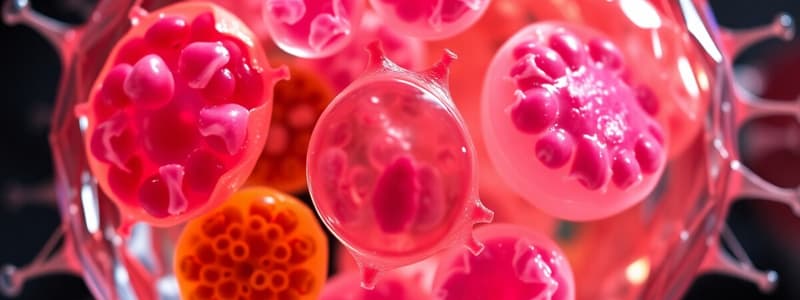Podcast
Questions and Answers
What is the primary function of lysosomes in a cell?
What is the primary function of lysosomes in a cell?
- Store nutrients and water
- Synthesize proteins
- Capture light energy for photosynthesis
- Break down waste materials and cellular debris (correct)
Which process is primarily responsible for producing gametes with half the number of chromosomes?
Which process is primarily responsible for producing gametes with half the number of chromosomes?
- Cellular respiration
- Binary fission
- Mitosis
- Meiosis (correct)
What distinguishes active transport from passive transport?
What distinguishes active transport from passive transport?
- Active transport occurs only in plant cells
- Passive transport involves the use of vesicles for transport
- Active transport is limited to small molecules only
- Active transport requires energy to move molecules against a concentration gradient (correct)
Which of the following cellular structures is involved in detoxifying harmful substances?
Which of the following cellular structures is involved in detoxifying harmful substances?
How do cells typically communicate with each other?
How do cells typically communicate with each other?
What is a key difference between prokaryotic and eukaryotic cells?
What is a key difference between prokaryotic and eukaryotic cells?
What is the primary function of the plasma membrane?
What is the primary function of the plasma membrane?
Which of the following correctly describes the cytoplasm?
Which of the following correctly describes the cytoplasm?
Which organelle is primarily responsible for energy production in eukaryotic cells?
Which organelle is primarily responsible for energy production in eukaryotic cells?
What role does the nucleus serve in a eukaryotic cell?
What role does the nucleus serve in a eukaryotic cell?
Flashcards
Prokaryotic Cell
Prokaryotic Cell
A type of cell without membrane-bound organelles; e.g., bacteria and archaea.
Eukaryotic Cell
Eukaryotic Cell
A type of cell with membrane-bound organelles; e.g., plant, animal, fungi, and protists.
Cell Membrane
Cell Membrane
The outer boundary of a cell, regulating what enters and exits.
Cytoplasm
Cytoplasm
Signup and view all the flashcards
Nucleus
Nucleus
Signup and view all the flashcards
Lysosome function
Lysosome function
Signup and view all the flashcards
Mitosis purpose
Mitosis purpose
Signup and view all the flashcards
Passive transport example
Passive transport example
Signup and view all the flashcards
Cell communication
Cell communication
Signup and view all the flashcards
Meiosis role
Meiosis role
Signup and view all the flashcards
Study Notes
Cell Structure and Function
- Cells are the basic units of life, exhibiting a wide variety of shapes and sizes.
- All cells share fundamental characteristics, including a plasma membrane, cytoplasm, and genetic material (DNA).
- Prokaryotic cells (bacteria and archaea) lack membrane-bound organelles, while eukaryotic cells (plants, animals, fungi, and protists) possess them.
Prokaryotic Cells
- Typically smaller and simpler than eukaryotic cells.
- Lack membrane-bound organelles like mitochondria, endoplasmic reticulum, or Golgi apparatus.
- Genetic material (DNA) is located in a nucleoid region.
- Often have cell walls for structural support and protection.
- Examples include bacteria and archaea, playing crucial roles in various ecosystems and human health.
Eukaryotic Cells
- Larger and more complex than prokaryotic cells.
- Possess membrane-bound organelles, compartmentalizing cellular functions.
- Contain a nucleus housing the genetic material (DNA).
- Exhibit diverse structures and functions depending on their specific roles in organisms.
Cell Membrane
- The plasma membrane encloses the cell, separating its interior from the external environment.
- Composed primarily of a phospholipid bilayer, with embedded proteins for various functions like transport and signaling.
- Selective permeability allows the passage of specific molecules while restricting others.
- Maintains a stable internal environment essential for cell survival.
Cytoplasm
- The region inside the cell membrane, excluding the nucleus.
- Contains various organelles suspended in a fluid cytosol.
- The site of numerous metabolic activities and cellular processes.
- Cytoskeleton provides structural support and facilitates intracellular transport.
Nucleus
- The control center of the eukaryotic cell, containing the cell's genetic material (DNA).
- Enclosed by a double membrane (nuclear envelope) with pores regulating passage of molecules.
- Houses chromosomes, which carry genetic information.
- Site of DNA replication and RNA transcription.
Organelles
- Specialized structures within the cytoplasm of eukaryotic cells, performing specific functions.
- Mitochondria are the "powerhouses" of the cell, generating energy through cellular respiration.
- Endoplasmic reticulum (ER) is a network of membranes involved in protein synthesis and lipid metabolism.
- Golgi apparatus modifies, sorts, and packages proteins for secretion.
- Lysosomes contain digestive enzymes to break down waste materials and cellular debris.
- Vacuoles store water, nutrients, and waste products.
- Ribosomes synthesize proteins according to genetic instructions.
- Chloroplasts (plant cells) capture light energy for photosynthesis.
- Peroxisomes break down fatty acids and detoxify harmful substances.
Cell Division
- Mitosis and meiosis are processes of cell division.
- Mitosis is used for growth, repair, and asexual reproduction in eukaryotic cells.
- Meiosis is involved in sexual reproduction, producing gametes with half the number of chromosomes.
- Precise regulation of cell division is crucial for maintaining organismal health.
Cell Transport
- Movement of molecules across the cell membrane is essential for maintaining cellular balance.
- Passive transport (diffusion, osmosis) occurs without energy expenditure.
- Active transport requires energy to move molecules against a concentration gradient.
- Endocytosis and exocytosis are processes for transporting large molecules.
Cell Signaling
- Cells communicate with each other through signaling pathways.
- Cells receive, process, and respond to signals from their environment.
- Signaling pathways can regulate various cellular activities, such as growth, differentiation, and metabolism.
Studying That Suits You
Use AI to generate personalized quizzes and flashcards to suit your learning preferences.




